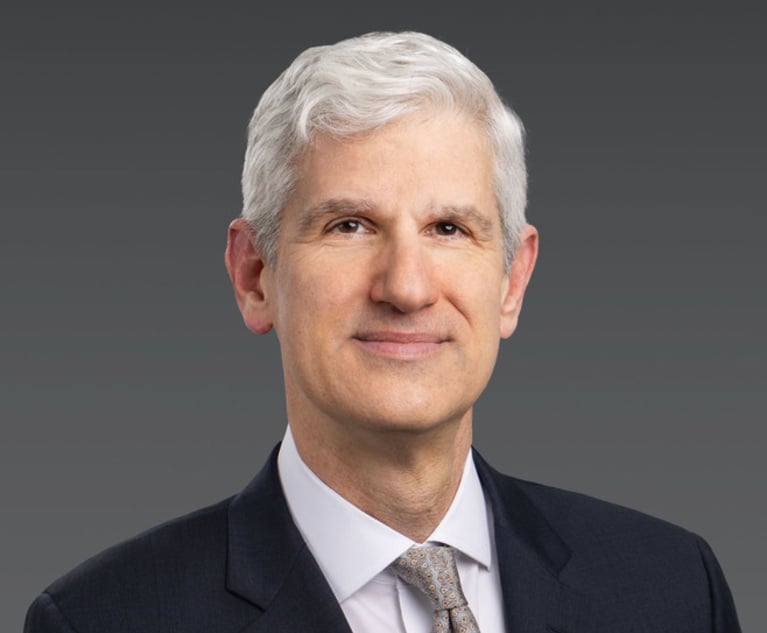Five Predictions for Litigation Finance in 2019
As litigation funding takes on a bigger role in the legal industry, the next year could bring with it a series of important changes.
November 27, 2018 at 10:49 AM
7 minute read

The past year in litigation finance has been riveting, at least for those of us in the thick of the industry. Next year promises to be just as eventful—perhaps even more so as the sector matures and faces new legal and competitive challenges.
In 2018 it seemed that every other week brought news of another funding company being hatched (including the one I lead, Validity Finance, which launched in June). Capital has rushed into our space like a flash flood into a canyon gully. Many of the benefits are obvious: for litigants, a wider choice of funders; for law firms, tools to boost profits and realization rates; and for the sector as a whole, a release of financial creativity generated by healthy competition.
Some of the potential concerns raised by this flood of capital are equally obvious: an industry focused on profits rather than on helping clients get their cases decided on the merits; inexperienced actors new to the complexities of litigation and economic risk; and nonlawyer funders who lack understanding of the ethics rules lawyers must follow.
Wall Street is driving much of the growth. Litigation has been discovered as a new asset class that's impervious to the gyrating stock market, to rising interest rates and to the economy as a whole.
Lawsuit finance is no longer in its infancy in the United States. What began as a financial tool for “David vs. Goliath” cases—small plaintiffs who used funding to sue large defendants in bet-the-company cases—has gone mainstream. In the next several years, sophisticated law firms in the Am Law 50 will routinely offer their clients financing options. These and many other firms will also use trusted funders to create department-by-department portfolio financings—bundled cases. These portfolios will help boost sorely needed profits and will better align firms' incentives with those of their clients. In the very near future, corporate law departments will use financing for defense funding.
But looking just to the year ahead, here are five predictions for litigation funding:
More Players
Still more entrants will launch into the crowded sea of litigation funding. The number of dedicated litigation funding shops could double, from about 20 or so to 50 or more, nationwide. Hedge funds will also continue to announce in-house funding investment units. It will take time—or an unforeseen event—for financiers to consider the market saturated or too uncertain to bet on.
Defense Funding
Defense-side litigation funding will begin to emerge as an important segment of the market. While routine financing of litigation risk by corporate law departments is still a few years away, bold and innovative companies are beginning to see the benefit of risk transfer to leading industry players. Imagine corporate law departments sharing defense fees with law firms and funders to precisely contain their spending on defense cases and complex litigation. Or law firms routinely able to take on fixed-fee defense work—capping defense spending for clients—with the help of funding. In exchange, law firms will reasonably ask for more cases and success fees to further align incentives with these clients. Law firms may also build defense funding into hybrid plaintiff-defense portfolios, to offer clients value in yet a third way.
No Initial Disclosure of Funding
There is likely to be at least a further year of study by the federal Advisory Committee on Civil Rules about whether initial disclosure of litigation funding should take place at the start of federal cases. (One threshold question: whether financings are likely to be relevant to the merits of any claim or defense, and whether it is proportional.)
In 2014, the nonprofit U.S. Chamber Institute for Legal Reform proposed an amendment to Rule 26 of the Federal Rules of Civil Procedure that would make disclosure of funding mandatory. At the time, the advisory committee decided that crafting rules would be premature. It noted that “questions raised by third-party financing are important. But they have not been fully identified, and may change as practices develop further.” The committee also pointed out that judges had the power to obtain information about third-party funding when relevant.
Last September, the advisory committee reported that it had formed a subcommittee to develop rules for multidistrict litigation proceedings. The subcommittee would also address the issue of disclosure of funding in MDL cases and “in other contexts.” The report concluded: “The subcommittee's work is at a very early stage—the list of issues and topics for study is still being developed.” In other words, any rule change on initial disclosure of funding is unlikely to be completed next year.
Self-Regulation
Expect an elite group of litigation finance companies to form an association to ensure ethical and sustainable funding practices. The result will likely be a code of best practices, perhaps similar to one recently published in the United Kingdom by the ICCA-Queen Mary Task Force for funding international arbitrations. The group will surely look to the U.K.'s self-regulating funding body, the Association of Litigation Funders, entering its eighth year of operation, and providing, among other functions, protections to clients, “including clarity on issues of control of case strategy, approval of settlements and withdrawal from cases.”
Debate Over Portfolio Funding
Expect a robust debate on the ethics of fee-splitting between lawyers and nonlawyers, such as major banks and litigation finance firms.
Rule 5.4(a) of the Model Rules of Professional Conduct currently forbids the sharing of legal fees with a nonlawyer. As litigation funders and law firms enter financing arrangements for baskets of commercial cases, a healthy debate will pit anachronistic and formal readings of the rule with more functional approaches. Such functional approaches look to the purpose of the rule: to protect clients by ensuring a lawyer's judgment isn't compromised by a third party. (The rule, by the way, is a muddle. Formally construed, law firms routinely violate it by paying for copier paper or electric utilities with fee proceeds.)
The debate began last August, when the New York City Bar Association, following the formalistic approach, found bank lines of credit did not violate Rule 5.4(a), but that portfolio transactions with funders did. The association's nonbinding interpretation of the rule did not distinguish between pressure lawyers may feel to make recourse payments to a bank (where all partners have pledged their personal assets), and completely nonrecourse obligations to funders if any cases in a portfolio generate fees. That's just the beginning of the problems raised by the association's opinion, which professional responsibility scholars have already critiqued in detail. It is rumored that the New York City Bar is re-examining its opinion and may retract or restate it. Counter-interpretations can be expected soon.
In 2018 there was a massive inflow of capital to the litigation finance industry, hastening its ability to assist litigants. In the year ahead, expect more cautiously positive growth. Funders will test new products and develop new approaches to defense funding, and law firms will approach their clients with these new financing tools. It should be exciting to watch, even from the sidelines.
Ralph Sutton is CEO and chief investment officer of Validity Finance, a litigation finance company launched in 2018.
This content has been archived. It is available through our partners, LexisNexis® and Bloomberg Law.
To view this content, please continue to their sites.
Not a Lexis Subscriber?
Subscribe Now
Not a Bloomberg Law Subscriber?
Subscribe Now
NOT FOR REPRINT
© 2025 ALM Global, LLC, All Rights Reserved. Request academic re-use from www.copyright.com. All other uses, submit a request to [email protected]. For more information visit Asset & Logo Licensing.
You Might Like
View All
Paul Hastings, Recruiting From Davis Polk, Adds Capital Markets Attorney
3 minute read
Kirkland Is Entering a New Market. Will Its Rates Get a Warm Welcome?
5 minute read

Goodwin Procter Relocates to Renewable-Powered Office in San Francisco’s Financial District
Trending Stories
- 1Charlie Javice Fraud Trial Delayed as Judge Denies Motion to Sever
- 2Holland & Knight Hires Former Davis Wright Tremaine Managing Partner in Seattle
- 3With DEI Rollbacks, Employment Attorneys See Potential for Targeting Corporate Commitment to Equality
- 4Trump Signs Executive Order Creating Strategic Digital Asset Reserve
- 5St. Jude Labs Sued for $14.3M for Allegedly Falling Short of Purchase Expectations
Who Got The Work
J. Brugh Lower of Gibbons has entered an appearance for industrial equipment supplier Devco Corporation in a pending trademark infringement lawsuit. The suit, accusing the defendant of selling knock-off Graco products, was filed Dec. 18 in New Jersey District Court by Rivkin Radler on behalf of Graco Inc. and Graco Minnesota. The case, assigned to U.S. District Judge Zahid N. Quraishi, is 3:24-cv-11294, Graco Inc. et al v. Devco Corporation.
Who Got The Work
Rebecca Maller-Stein and Kent A. Yalowitz of Arnold & Porter Kaye Scholer have entered their appearances for Hanaco Venture Capital and its executives, Lior Prosor and David Frankel, in a pending securities lawsuit. The action, filed on Dec. 24 in New York Southern District Court by Zell, Aron & Co. on behalf of Goldeneye Advisors, accuses the defendants of negligently and fraudulently managing the plaintiff's $1 million investment. The case, assigned to U.S. District Judge Vernon S. Broderick, is 1:24-cv-09918, Goldeneye Advisors, LLC v. Hanaco Venture Capital, Ltd. et al.
Who Got The Work
Attorneys from A&O Shearman has stepped in as defense counsel for Toronto-Dominion Bank and other defendants in a pending securities class action. The suit, filed Dec. 11 in New York Southern District Court by Bleichmar Fonti & Auld, accuses the defendants of concealing the bank's 'pervasive' deficiencies in regards to its compliance with the Bank Secrecy Act and the quality of its anti-money laundering controls. The case, assigned to U.S. District Judge Arun Subramanian, is 1:24-cv-09445, Gonzalez v. The Toronto-Dominion Bank et al.
Who Got The Work
Crown Castle International, a Pennsylvania company providing shared communications infrastructure, has turned to Luke D. Wolf of Gordon Rees Scully Mansukhani to fend off a pending breach-of-contract lawsuit. The court action, filed Nov. 25 in Michigan Eastern District Court by Hooper Hathaway PC on behalf of The Town Residences LLC, accuses Crown Castle of failing to transfer approximately $30,000 in utility payments from T-Mobile in breach of a roof-top lease and assignment agreement. The case, assigned to U.S. District Judge Susan K. Declercq, is 2:24-cv-13131, The Town Residences LLC v. T-Mobile US, Inc. et al.
Who Got The Work
Wilfred P. Coronato and Daniel M. Schwartz of McCarter & English have stepped in as defense counsel to Electrolux Home Products Inc. in a pending product liability lawsuit. The court action, filed Nov. 26 in New York Eastern District Court by Poulos Lopiccolo PC and Nagel Rice LLP on behalf of David Stern, alleges that the defendant's refrigerators’ drawers and shelving repeatedly break and fall apart within months after purchase. The case, assigned to U.S. District Judge Joan M. Azrack, is 2:24-cv-08204, Stern v. Electrolux Home Products, Inc.
Featured Firms
Law Offices of Gary Martin Hays & Associates, P.C.
(470) 294-1674
Law Offices of Mark E. Salomone
(857) 444-6468
Smith & Hassler
(713) 739-1250










